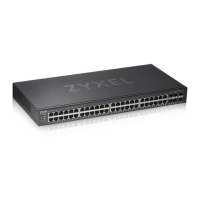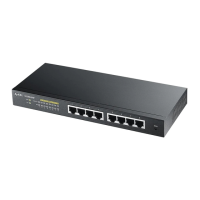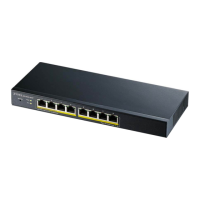Chapter 4 Web Configurator
GS1920v2 Series User’s Guide
62
Diffserv This link takes you to screens where you can enable DiffServ, configure marking rules and set
DSCP-to-IEEE802.1p mappings.
Queuing
Method
This link takes you to a screen where you can set priorities for the queues of the Switch. This distrib-
utes bandwidth across the different traffic queues.
Priority
Queue
This link takes you to a screen where you can set priority tags for different traffic types and specify
the priority levels.
Bandwidth
Control
This link takes you to a screen where you can cap the maximum bandwidth allowed on a port.
Spanning Tree
Protocol
Click the link to unfold the following sub-link menu.
Spanning
Tree
Protocol
Status
This link takes you to a screen where you can view the STP status in the different STP modes (RSTP,
MRSTP or MSTP) you can configure on the Switch.
Spanning
Tree Setup
This link takes you to a screen where you can activate one of the STP modes (RSTP, MRSTP or
MSTP) on the Switch.
RSTP This link takes you to a screen where you can configure the RSTP (Rapid Spanning Tree Protocol)
settings on the Switch.
MRSTP This link takes you to a screen where you can configure the MRSTP (Multiple Rapid Spanning Tree
Protocol) settings on the Switch.
MSTP This link takes you to a screen where you can configure the MSTP (Multiple Spanning Tree Proto-
col) settings on the Switch.
Static MAC Fil-
tering
This link takes you to a screen to set up static MAC filtering rules.
Static MAC For-
warding
This link takes you to a screen where you can configure static MAC addresses for a port. These
static MAC addresses do not age out.
VLAN Click the link to unfold the following sub-link menu.
VLAN
Status
This link takes you to a screen where you can view and search all VLAN groups.
VLAN Setup This link takes you to screens where you can:
• configure port-based or 802.1Q VLAN.
• view detailed port settings and status of the VLAN group.
• configure and view 802.1Q VLAN parameters for the Switch.
• configure the static VLAN settings on a port.
Subnet
Based
VLAN Setup
This link takes you to a screen where you can set up VLANs that allow you to group traffic into log-
ical VLANs based on the source IP subnet you specify.
Protocol
Based
VLAN Setup
This link takes you to a screen where you can set up VLANs that allow you to group traffic into log-
ical VLANs based on the protocol you specify.
Voice
VLAN Setup
This link takes you to a screen where you can set up VLANs that allow you to group voice traffic
with defined priority and enable the Switch port to carry the voice traffic separately from data
traffic to ensure the sound quality does NOT deteriorate.
MAC Based
VLAN Setup
This link takes you to a screen where you can set up VLANs that allow you to group untagged
packets into logical VLANs based on the source MAC address of the packet. This eliminates the
need to reconfigure the Switch when you change ports. The Switch will forward the packets
based on the source MAC address you set up previously.
Vendor ID
Based
VLAN Setup
This link takes you to screens where you can set up VLANs that allow you to group untagged
packets into logical VLANs based on the source MAC address of the packet. You can specify a
mask for the MAC address to create a MAC address filter and enter a weight to set the VLAN
rule’s priority.
VLAN Isolation This link takes you to a screen where you can block traffic between ports in a VLAN on the Switch.
Table 11 Navigation Panel Links (continued)
LINK DESCRIPTION

